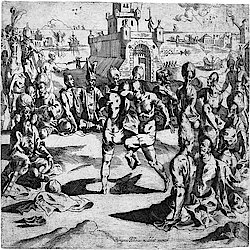Loading the page ...
Romano Alberti
ca. 1555 Borgo San Sepolcro - between 1599 and 1604 Rome
Romano Alberti was a member of a large, well-known family of artists from Borgo San Sepolcro, active from the late thirteenth century up to about 1675. The members of this dynasty were very versatile, and often active in several artistic disciplines: as painters and fresco painters, sculptors, woodcarvers, printmakers, architects, military engineers, armorers, and writers of history and literature. The achievements of individual members of the Alberti family have only been fragmentarily recorded in the art-historical literature, either because large areas of their artistic output have not survived, or because their specific contributions to significant projects, which were often executed by a team, cannot be established. This is especially true of the versatile artist Romano Alberti, who worked as a painter, sculptor and printmaker. In Rome, he and Taddeo Zuccaro were among the reformers of the Accademia di S. Luca, where he served as secretary from 1593 to at least 1599. Due to an illicit affair with a woman, Romano was sentenced to death in 1588 and fled from Rome to Venice, where he was supported by the painter and poet Andrea Cornaro. Shortly afterwards, and probably inspired by a craving for adventure, Romano turned up on the Greek island of Crete with the Venetian army. Due to exemption from punishment, he returned in 1590 to Rome. While he was not very successful as a painter, however, Romano became very famous as an art theorist at the Accademia di S. Luca. His treatise Origine, et Progresso published in 1599 is now considered the most important primary source on this distinguished institution. Alberto also composed love poems and made translations of the works of Classical authors.
Archive
